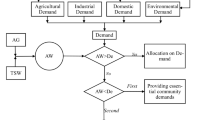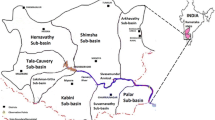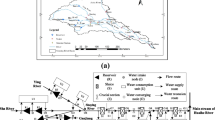Abstract
Reallocating water resources to satisfy human and environmental water requirements in a balanced manner within a basin constitutes a challenge task in water resources management. This study aims to develop a basin-scale multi-purposes operation model coupled with a multi-criteria optimization framework to investigate values of coordinated releasing rules for maintaining streamflow variability at different river reaches. The proposed approach is applied to the Hsintien Creek basin (northern Taiwan) to explore four management scenarios. The results indicate that the no-environmental-flow scenario is most favorable to human benefits. But severe hydrologic alteration at all reaches leads to the worst overall performance of 0.521, which is a multi-criteria index based on normalized human-benefit and environmental objectives and ranges between 0 and 1. The current rule releasing minimum environmental flows at some reaches receives an improvement at those reaches and has a slightly improved overall index of 0.530. Sustaining minimum environmental flows at all reaches does not provide a further overall improvement of 0.530 since mitigation of hydrologic alteration at those reaches is offset by deterioration of human benefits. The best overall performance of 0.620 is achieved by the basin-scale optimization for deriving the coordinated operation rules and time-varying environmental flow releases that lead to the most compromising alternative between conflicting human and environmental objectives.





Similar content being viewed by others
References
Ahmad A, El-Shafie A, Razali SFM, Mohamad ZS (2014) Reservoir optimization in water resources: a review. Water Resour Manage 28(11):3391–3405
Bunn SE, Arthington AH (2002) Basic principles and ecological consequences of altered flow regimes for aquatic biodiversity. Environ Manage 30(4):492–507
Cai W, Zhang L, Zhu X, Zhang A, Yin J, Wang H (2013) Optimized reservoir operation to balance human and environmental requirements: a case study for the Three Gorge and Gezhouba Dams, Yangtze River basin, China. Ecol Inform 18:40–48
Cardwell H, Jager JI, Sale MJ (1996) Designing instream flows to satisfy fish and human water needs. J Water Resour Plan Manage 122(5):356–363
Chen Q, Chen D, Li R, Ma J, Blanckaert K (2013) Adapting the operation of two cascaded reservoirs for ecological flow requirement of a de-watered river channel due to diversion-type hydropower stations. Ecol Model 252:266–272
Cioffi F, Gallerano F (2012) Multi-objective analysis of dam release flows in rivers downstream from hydropower reservoirs. Appl Math Model 36(7):2868–2889
Gao Y, Vogel RM, Kroll CN, Poff NL, Olden JD (2009) Development of representative indicators of hydrologic alteration. J Hydrol 374:136–147
Harman C, Stewardson M (2005) Optimizing dam release rules to meet environmental flow targets. River Res Appl 21(2–3):113–129
Hwang CL, Yoon K (1981) Multiple attribute decision making: methods and applications. Springer-Verlag, Berlin
Jowett IG (1997) Instream flow methods: a comparison of approaches. Regul Rivers: Res Manage 13(2):115–127
Jowett IG, Biggs BJF (2006) Flow regime requirements and the biological effectiveness of habitat-based minimum flow assessments for six rivers. Int J River Basin Manage 4(3):179–189
Labadie J (2004) Optimal operation of multi-reservoir systems: state-of-the-art review. J Water Resour Plan Manage 125(3):145–153
Monk WA, Wood PJ, Hannah DM, Wilson DA (2007) Selection of river flow indices for the assessment of hydroecological change. River Res Appl 23(1):113–122
Paredes-Arquiola J, Martinez-Capel F, Solera A, Aguilella V (2013) Implementing environmental flows in complex water resources systems—case study: the Duero River basin Spain. River Res Appl 29(4):451–468
Petts GE, Nestler J, Kennedy R (2006) Advancing science for water resources management. Hydrobiologia 565(1):277–288
Poff NL, Allan JD, Bain MB, Karr JR, Prestegaard KL, Richter BD, Sparks RE, Stromberg JC (1997) The natural flow regime: a paradigm for river conservation and restoration. Bioscience 47(11):769–784
Reichold L, Zechman EM, Brill ED, Holmes H (2010) Simulation-optimization framework to support sustainable watershed development by mimicking the predevelopment flow regime. J Water Resour Plan Manage 136(3):366–375
Richter BD, Baumgartner JV, Wigington R, Braun DP (1997) How much water does a river need. Freshw Biol 37(1):231–249
Sale MJ, Brill ED, Herricks EE (1982) An approach to optimizing reservoir operation for downstream aquatic resources. Water Resour Res 18(4):705–712
Schmidt JC, Wilcock PR (2008) Metrics for assessing the downstream effects of dams. Water Resour Res 44(4):W04404. doi:10.1029/2006WR005092
Shiau JT, Huang CY (2014) Detecting multi-purpose reservoir operation induced time-frequency alteration using wavelet transform. Water Resour Manage 28(11):3577–3590
Shiau JT, Wu FC (2006) Compromise programming methodology for determining instream flow under multiobjective water allocation criteria. J Am Water Resour Assoc 42(5):1179–1191
Shiau JT, Wu FC (2007) Pareto-optimal solutions for environmental flow schemes incorporating the intra-annual and interannual variability of the natural flow regime. Water Resour Res 43(6):W06433. doi:10.1029/2006WR005523
Shiau JT, Wu FC (2010) A dual active-restrictive approach to incorporating environmental flow targets into existing reservoir operation rules. Water Resour Res 46(8):W08515. doi:10.1029/2009WR008765
Shiau JT, Wu FC (2013) Optimizing environmental flows for multiple reaches affected by a multipurpose reservoir system in Taiwan: restoring the natural flow regime at multiple temporal scales. Water Resour Res 49(1):565–584
Stanford JA, Ward JV, Liss WJ, Frissell CA, Williams RN, Lichatowich JA, Coutant CC (1996) A general protocol for restoration of regulated rivers. Regul Rivers: Res Manage 12(4–5):391–413
Steinschneider S, Bernstein A, Palmer R, Polebitski A (2014) Reservoir management optimization for basin-wide ecological restoration in the Connecticut River. J Water Resour Plan Manage 140(9):04014023
Suen JP, Eheart JW (2006) Reservoir management to balance ecosystem and human needs: incorporating the paradigm of the ecological flow regime. Water Resour Res 42(3):W03417. doi:10.1029/2005WR004314
Szemis JM, Dandy GC, Maier HR (2013) A multiobjective ant colony optimization approach for scheduling environmental flow management alternatives with application to the River Murray Australia. Water Resour Res 49(10):6393–6411
Szemis JM, Maier HR, Dandy GC (2014) An adaptive ant colony optimization framework for scheduling environmental flow management alternatives under varied environmental water availability conditions. Water Resour Res 50(10):7606–7625
Wang H, Brill ED, Ranjithan RS, Sankarasubramanian A (2015) A framework for incorporating ecological releases in single reservoir operation. Adv Water Resour 78:9–21
Wohl E, Angermeier PL, Bledsoe B, Kondofl GL, MacDonnekk L, Merritt Palmer MA, Poff NL, Tarboton D (2005) River restoration. Water Resour Res 41(10):W10301. doi:10.1029/2005WR003085
Wu FC, Chang CF, Shiau JT (2015) Assessment of flow regime alterations over a spectrum of temporal scales using wavelet-based approaches. Water Resour Res 51(5):3317–3338
Yang N, Mei Y, Zhou C (2012) An optimal reservoir operation model based on ecological requirement and its effect on electricity generation. Water Resour Manage 26(14):4019–4028
Yin XA, Yang ZF, Petts GE (2011) Reservoir operating rules to sustain environmental flows in regulated rivers. Water Resour Res 47(8):W08509. doi:10.1029/2010WR009991
Yin XA, Yang ZF, Petts GE, Kondolf GM (2014) A reservoir operating method for riverine ecosystem protection, reservoir sedimentation control and water supply. J Hydrol 512:379–387
Acknowledgments
Financial support for this study was graciously provided by the National Science Council, Taiwan, ROC (NSC 99-2221-E-006-191-MY3). The authors also appreciate the Taipei Feitsui Reservoir Administration and Taiwan Power Company for providing data. Valuable comments from anonymous reviewers for improving presentation are greatly appreciated.
Author information
Authors and Affiliations
Corresponding author
Ethics declarations
The authors claim that (1) source of funding of this study was provided by the National Science Council, Taiwan, ROC (NSC 99-2221-E-006-191-MY3); (2) no potential conflicts of interest; and (3) no human participants and/or animals are involved in this study.
Rights and permissions
About this article
Cite this article
Shiau, JT., Chou, HY. Basin-scale optimal trade-off between human and environmental water requirements in Hsintien Creek basin, Taiwan. Environ Earth Sci 75, 644 (2016). https://doi.org/10.1007/s12665-016-5427-6
Received:
Accepted:
Published:
DOI: https://doi.org/10.1007/s12665-016-5427-6




